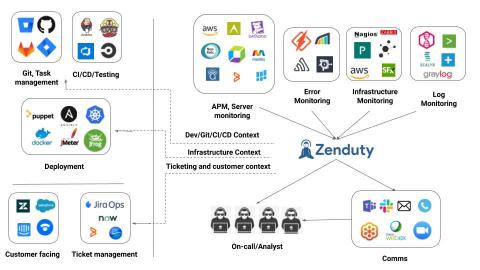Operations | Monitoring | ITSM | DevOps | Cloud
May 2020
Using context to triage change-triggered incidents
One of the first things incident managers do when they get an alert page from Zenduty is to check the “Context” tab of the incident. Incident context is extremely critical to get a first responder’s view of what happened and what could possibly have caused it. Context tells you what happened before an incident. In the case of 40–50% of all incidents, Zenduty’s incident context can tell you within 5–10 seconds, what could be the cause of an incident.
Real-time alerts from Zabbix and escalation with Zenduty
Recently, one of our customers, a 20-member NOC team of a large B2C company, had set up Zabbix to monitor a network of over 1000+ servers, routers, and switches. The NOC team wanted to set up alerting, on-call scheduling, and an escalation matrix whenever a critical network component encountered any downtime. The NOC team used Slack as the primary communication channel and Zoom for real-time communication. For NOC teams like these running a very large operation, setting up alerting can be very tricky.
Accelerating your Zendesk customer support response times by 50% and meeting support SLAs
Zendesk is one of the most popular ticketing support and customer service platforms available in the market. Two metrics that measure the effectiveness of your customer support are the response and resolution times — how soon are you able to respond to a customer ticket, and how soon are you able to mobilize relevant personnel, perform necessary remediation tasks and finally resolve the ticket.
Monitoring service health and downtime events within your Google Cloud with Zenduty
Google Cloud Platform (GCP) is a collection of Google’s computing resources, made available via services to the general public as a public cloud offering. The GCP resources consist of physical hardware infrastructure — computers, hard disk drives, solid-state drives, and networking — contained within Google’s globally distributed data centers, where any of the components are custom designed using patterns similar to those available in the Open Compute Project.






